The BT medium tank series was modeled after an American M1931Christie tank that was bought by the Soviet Purchasing Commission.
Like the M1931 Christie tank, the Soviet BT medium tanks could run either on tracks or on the four large road wheels that were on either side of the tank.
BT-1, which was produced for only a limited time, had an all-riveted construction, like the Christie. The BT-1’s turret, which had two machine guns, was similar to the Christie’s turret.
The first major production model in the BT series was the BT-2, which was about a ton heavier than the BT-1.
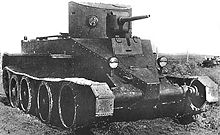
The BT-2 had a new turret with a 1.46 inch (37mm) gun and a machinegun.
The BT-2 was followed by the BT-3/BT-4. This model was similar to the BT-2, but had solid disk wheels instead of spoked wheels. The main armament of the BT-3/BT-4 was a 1.77 inch (45mm) gun.
Although production of the BT-3/BT-4 was limited, some models were converted for special purposes. One had its gun removed and a folding wooden bridge added. Another had a flamethrower mounted on a new turret. Neither of these conversion models ever went into full production.
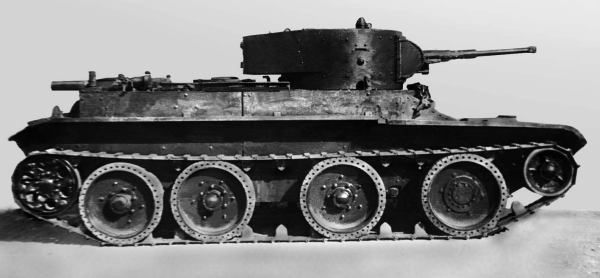
The BT-5 was a major production model. It had a more powerful new engine and a stronger suspension. Its cylindrical turret, which mounted a 1.77 inch (45mm gun), was larger than the turrets of its predecessors. The BT-5 also had improved vision devices.
A variant for close support work, the BT-5A model had a 3 inch (76.2mm) howitzer instead of the 1.77 inch gun.
A command version of the BT-5 had an internal radio at the rear of the tank. The turret was surrounded by a frame aerial.
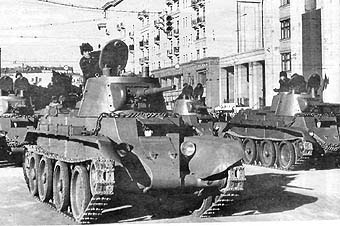
The BT-7 used an all-welded construction. Its engine was even newer and more powerful. It had a new gearbox, thicker armor, and more space for extra ammunition and fuel.
All but the earliest models of the BT-7 had a new conical turret that had a ball-mounted machine gun in the rear.
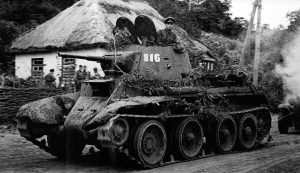
Like the BT-5, the BT-7 had a command version and a close-support version. The command version was known as the BT-7-1 (V). The close-support version had a 3 inch howitzer.
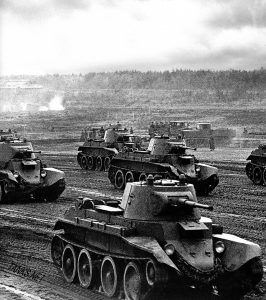
From the beginning of the war until the end of 1941, the BT-7 was the most common Soviet tank in service.
At the end of 1941, the BT-7 was drastically redesigned. A newer, more streamlined model, the BT-7M, which was also known as the BT-8, was developed.
The BT-8 had a new V2 diesel engine. It also had a sloped front glacis instead of a V-nose. The BT-8’s turret was the same as that of the T-28 medium tank.
The last tank in the BT series was the BT-IS. This was the first Soviet tank to have sloping side armor.
The BT-IS never went into full production. It was only built as a prototype.
BT Medium |
|
|---|---|
| Active: | BT-1: 1932; BT-2: 1933; BT-5: 1935; BT-7: 1936 |
| Crew: | 3 |
| Weight: | BT-1: 10 tons (10,200kg); BT-2: 11 tons (11,200kg); BT-5: 11.3 tons (11,500kg); BT-7: 13.7 tons (13,900kg) |
| Length: | BT-1: 18ft (5.49m); BT-2: 18ft (5.49m); BT-5: 18ft (5.49m); BT-7: 18ft7in (5.66m) |
| Height: | BT-1: 6ft 4in (1.93m); BT-2: 6ft 4in (1.93m); BT-5: 7ft 3in (2.21m); BT-7: 7ft 11in (2.41m) |
| Width: | BT-1: 7ft 4in (2.24m); BT-2: 7ft 4in (2.24m); BT-5: 7ft 4in (2.24m); BT-7: 7ft 11.5in (2.43m) |
| Weapons: | Main – BT-1: 2 x machineguns; BT-2: 1 x 1.46in (37mm) gun; BT-5 and BT-7: 1 x 1.77in (45mm) gun Secondary – All except BT-7: 1 x 0.3 in (7.62mm) DT machinegun; BT-7: 2 x 0.3 in (7.62 mm) DT machineguns |
| Armor | Maximum – All except BT-7: 0.5in (13mm); BT-7: 0.87in (22mm) |
| Engine: | All except BT-7: Liberty Aero V12 gasoline, 400hp; BT-7: M-15T V12 Gasoline, 450 hp |
| Speed: | Tracks – All except BT-7: 40mph (65kph); BT-7: 45mph (72kph) Wheels – BT-1 and BT-2: 65mph (105kph); BT-5: 70mph (112kph) |
| Range: | Tracks – All except BT-7: about 124 miles (200 km); BT-7: about 249 miles (400 km) Wheels – All except BT-7: about 186 miles (300 km); BT-7: about 311 miles (500 km) |